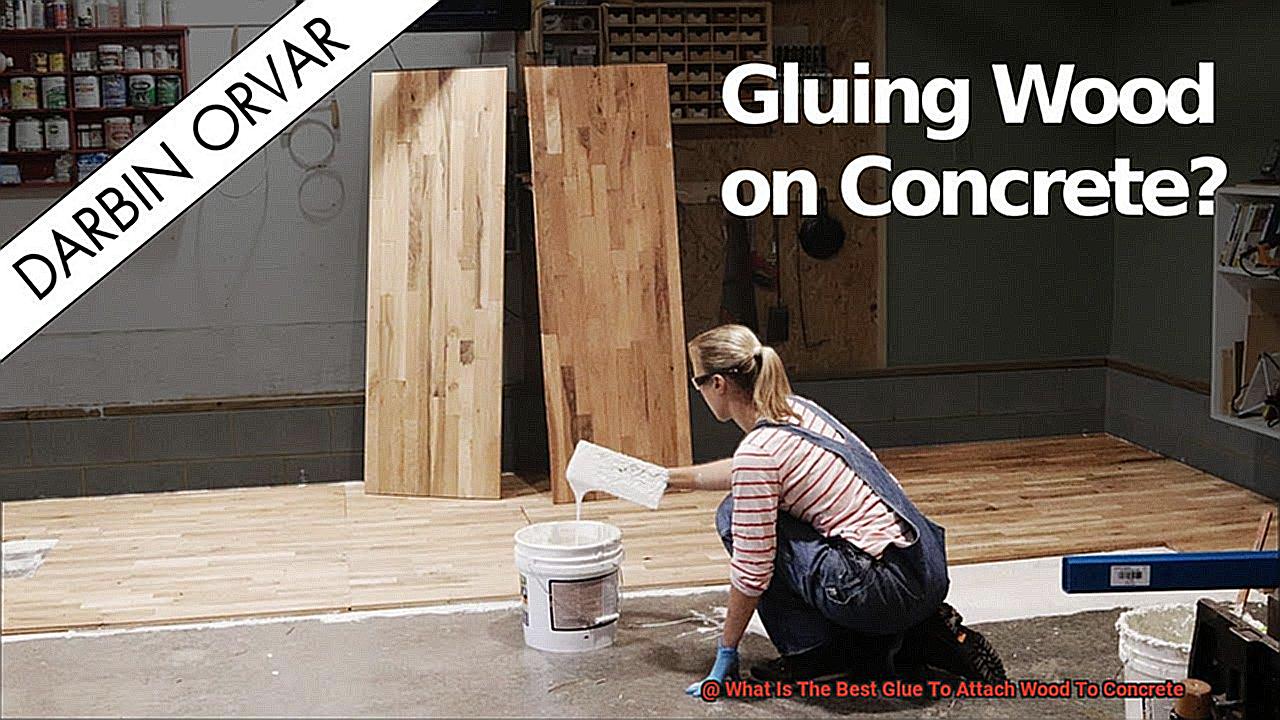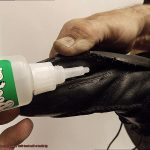Ever found yourself in a DIY dilemma, pondering how on earth to securely attach wood to concrete? Whether you’re constructing a deck, installing baseboards, or crafting a one-of-a-kind furniture piece, the challenge lies in finding that holy grail of glues – the one that can conquer the seemingly impossible task of bonding these two materials together. Fear not, intrepid craftsmen and craftswomen, because we’re about to unveil the secrets of this sticky situation.
Imagine this: a breathtaking patio adorned with a wooden pergola, where you can revel in sunsets like never before; or picture-perfect rustic shelves gracefully adorning your living room walls. But how do you turn these visions into reality, ensuring your handiwork stands strong against the test of time?
The answer lies within the realm of adhesive mastery. While there’s no shortage of glue options out there, not all are created equal when it comes to bonding wood and concrete. Join us on this captivating journey as we delve into the characteristics of top-notch glue and arm you with practical insights to become a master at combining these contrasting materials.
In this article, we’ll dive deep into key features to consider when selecting your glue – from its unparalleled bonding strength to its unwavering resistance against moisture and temperature fluctuations. Get ready to unravel the wonders concealed within construction adhesives, epoxy resin, and polyurethane glue as we shed light on their individual superpowers.
So strap in for an exhilarating expedition through the world of adhesives as we unearth the secret behind that perfect bond. By the end, you’ll be armed with knowledge and confidence for all your wood-to-concrete projects. Prepare to transform ordinary spaces into extraordinary showcases of craftsmanship while turning your creative dreams into tangible reality.
Types of Adhesive for Wood to Concrete Bonding
Contents
- 1 Types of Adhesive for Wood to Concrete Bonding
- 2 Factors to Consider When Choosing the Best Glue
- 3 Preparing the Surfaces for Bonding
- 4 Applying the Adhesive Correctly
- 5 Using Mechanical Fasteners in Conjunction with Glue
- 6 Special Considerations for Certain Types of Wood
- 7 Consulting Experts or Professionals
- 8 Conclusion
When it comes to joining wood and concrete, selecting the ideal adhesive is crucial for creating a bond that will withstand the test of time. In this article, we will delve into the various types of adhesives available for wood to concrete bonding, exploring their unique qualities and drawbacks. Let’s embark on this adhesive adventure.
Epoxy Adhesives:
Epoxy adhesives reign supreme in the realm of wood to concrete bonding, renowned for their unparalleled strength and durability. These adhesives possess the ability to bear heavy loads and exhibit resistance to moisture, chemicals, and temperature fluctuations. Nevertheless, working with epoxy can be a meticulous process as it demands precise mixing and boasts a lengthier curing time. Success lies in adhering closely to the manufacturer’s instructions.
Polyurethane Adhesives:
Flexibility and bond strength are the hallmarks of polyurethane adhesives, making them a viable option for securing wood to concrete. Their resistance to moisture and changes in temperature renders them suitable for both indoor and outdoor applications. However, patience is key when utilizing polyurethane adhesives as they tend to require a longer curing period compared to their epoxy counterparts. A steadfast commitment to allowing sufficient curing time ensures an unyielding and enduring bond.
Construction Adhesive:
For those seeking versatility, construction adhesive emerges as a worthy contender for wood to concrete bonding. These adhesives offer ease of use while delivering a robust connection between wood and concrete surfaces. Quick-drying properties expedite project completion without compromising strength. Nevertheless, it should be noted that construction adhesives may not possess the same level of tenacity as epoxy or polyurethane adhesives, making them more suited for lighter applications.
Specialty Adhesives:
Tailored specifically for wood to concrete bonding, specialty adhesives like liquid nails or panel adhesive provide a harmonious blend of strength and simplicity. These adhesives boast commendable bond strength and user-friendly application, making them suitable for a wide array of projects. However, it is essential to recognize that specialty adhesives may not exhibit the same level of durability and resistance as epoxy or polyurethane adhesives. When choosing a specialty adhesive, carefully consider the unique demands of your project.
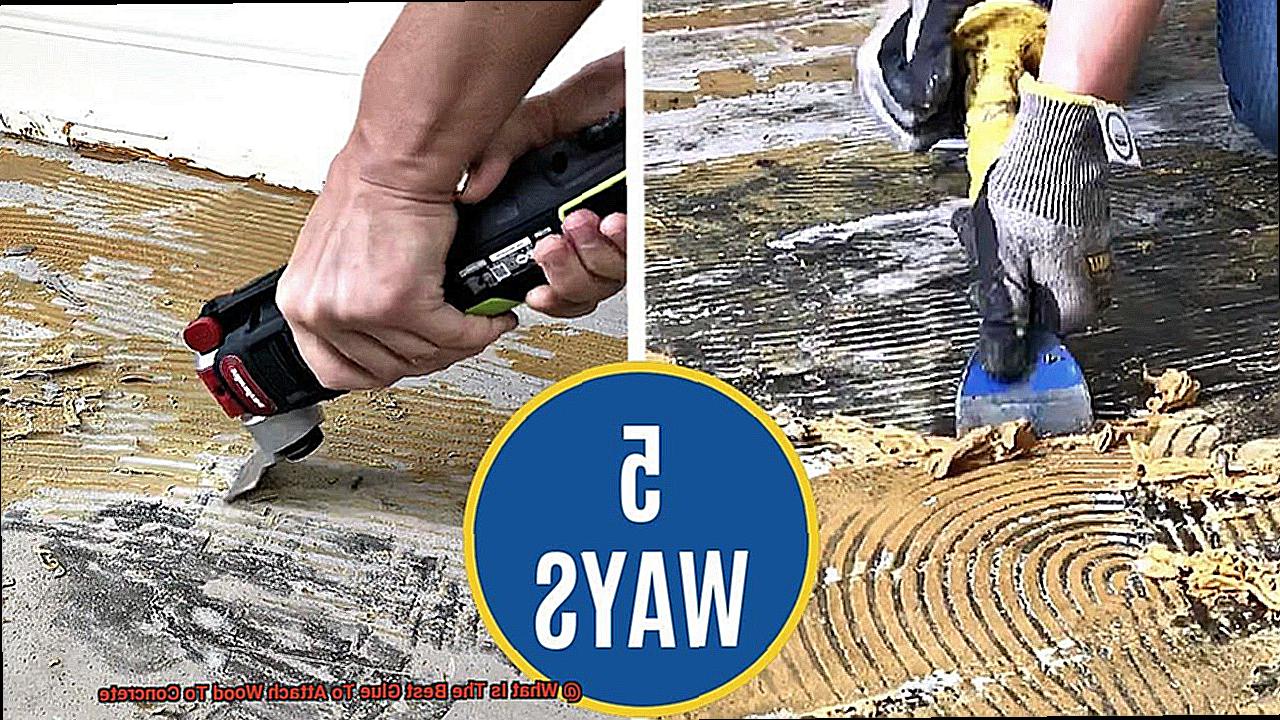
Considerations for the Perfect Adhesive:
Selecting the ideal adhesive requires careful consideration of your project’s specific requirements. Factors such as load-bearing capacity, exposure to moisture or weathering, and ease of use should all be weighed in the decision-making process. Furthermore, proper surface preparation is paramount to achieve a robust bond.
Ensure that both wood and concrete surfaces are immaculately clean, dry, and free from any debris before embarking on the adhesive application process.
Factors to Consider When Choosing the Best Glue
Well, get ready because I’m here to guide you through the six essential factors you need to consider when choosing the best glue for your project. So grab a cup of coffee, sit back, and let’s dive in.
First and foremost, let’s talk about bonding strength. When it comes to attaching wood to concrete, you need a glue that can create a bond as strong as steel. Look for glues specifically designed for this purpose that have a powerful adhesive property. Epoxy-based glues are renowned for their exceptional bonding strength and are often the go-to choice for wood to concrete applications.
Next up, compatibility is key. It’s crucial to ensure that the glue you choose is compatible with both wood and concrete surfaces. Some glues may not adhere well to certain types of wood or concrete, resulting in a feeble bond or even complete failure. To avoid disappointment, check the product label or manufacturer’s instructions to ensure compatibility. Additionally, take into consideration the porosity of the concrete surface. If it’s too smooth or sealed, you may need to roughen it up or use a primer to enhance the bonding ability of the glue.
Time is precious, my friend. Drying time is an important factor to consider, especially if you’re working against a tight deadline. Some glues require longer drying times, while others dry in a flash. Select a glue that aligns with your project requirements and allows ample time for proper positioning and alignment before setting.
Now let’s turn our attention to waterproof and weather resistance. Depending on your project, it may be vital to choose a glue that offers these invaluable properties. If your glued joint will face moisture or varying weather conditions, such as in outdoor projects or high humidity areas, opt for a glue specifically formulated for such environments. This ensures that the bond remains unyielding and intact, even in the face of challenging conditions.
Ease of use is another factor to consider. Some glues come in handy applicator bottles or tubes, making application a breeze. Others may require additional tools or mixing. Choose a glue that suits your expertise level and the complexity of your project. If you’re a novice or have limited experience with adhesives, opt for user-friendly options that provide clear instructions and effortless application.
Preparing the Surfaces for Bonding
Today, we’re going deep into the fascinating world of preparing surfaces for bonding when attaching wood to concrete using glue. This step is absolutely critical if you want a bond that will withstand the test of time. So, let’s roll up our sleeves and dive into this important task.
First things first, cleanliness is key. Both the wood and concrete surfaces need to be immaculate before even thinking about applying any glue. Dust, dirt, and debris can seriously hinder the adhesive’s ability to create a strong bond. So grab yourself a trusty brush or cloth and give that wood surface a thorough cleaning to banish any loose particles. And if your wood is stained or painted, don’t forget to give it a gentle sanding to create a rougher surface that allows for better adhesion.
But wait, we can’t forget about the concrete. It also needs some serious TLC. Arm yourself with a stiff brush or broom and go to town on that concrete surface, getting rid of any loose particles, dirt, or grease. We want nothing standing in the way of that perfect bond. And if there are any existing coatings or sealants on the concrete, make sure to remove them using appropriate methods like grinding or scraping.
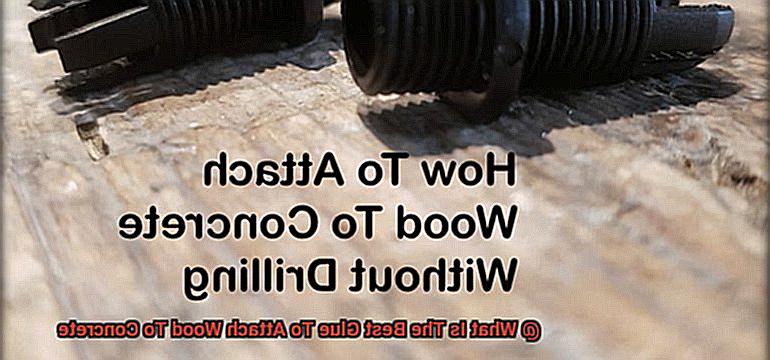
But here’s where things get really interesting – porosity. Yes, you heard right. Porosity plays a major role in how well wood and concrete bond together. To take your bonding game to the next level, it’s highly recommended to apply a primer or sealer compatible with both materials. This magical elixir helps create a surface that allows the adhesive to penetrate and bond like never before. Just make sure to follow the manufacturer’s instructions and give it ample time to dry before proceeding.
Now, let’s talk about roughing things up. Sometimes, roughness is what we need for a stronger bond. If you’re truly committed to achieving the tightest grip possible, consider roughening up both the wood and concrete surfaces. Grab some sandpaper or a wire brush and give those surfaces a good workout. This will create a rough texture that provides more surface area for the adhesive to cling onto. Trust me, this extra effort will pay off in a bond that’s unbreakable.
Applying the Adhesive Correctly
In our previous adventure, we learned how crucial surface preparation is for achieving a bond that can withstand the test of time. Now, it’s time to dive into the exciting realm of applying adhesive correctly. So grab your tool belt and let’s embark on this journey towards unbreakable connections.
Step 1: Prepare, Prepare, Prepare.
Cleanliness is key in this captivating endeavor. Rid both wood and concrete surfaces of any dirt, dust, or debris. A thorough sweep or brush-down will banish those pesky particles. And don’t forget about your stained or painted wood – give it a gentle sanding to create a rougher surface that fosters better adhesion.
Step 2: A Little Roughness Goes a Long Way
Now here’s where things get interesting – roughening up the surfaces. With sandpaper or a wire brush in hand, create a textured landscape that provides ample area for the adhesive to cling onto. But remember, moderation is key. Don’t go overboard and jeopardize the structural integrity of the concrete.
Step 3: Choosing the Right Adhesive
Ah, the thrill of selecting the perfect adhesive. Seek out an adhesive specifically designed for bonding wood to concrete. Construction adhesive or epoxy are popular choices. Ensure its compatibility with both materials and suitability for your intended application.
Step 4: Test, Test, Test.
Before taking the plunge and applying the adhesive, conduct a small-scale experiment on an inconspicuous area. Gauge its compatibility with the materials and ensure no unwanted discoloration or damage occurs.
Step 5: Apply with Precision
Now comes the moment you’ve been waiting for – applying the adhesive. Wield a trowel or putty knife to spread an even layer onto one of the surfaces, keeping a watchful eye on the adhesive manufacturer’s instructions. Be generous enough to ensure full coverage but avoid excessive amounts that could lead to messy joints or excessive squeeze out.
Using Mechanical Fasteners in Conjunction with Glue
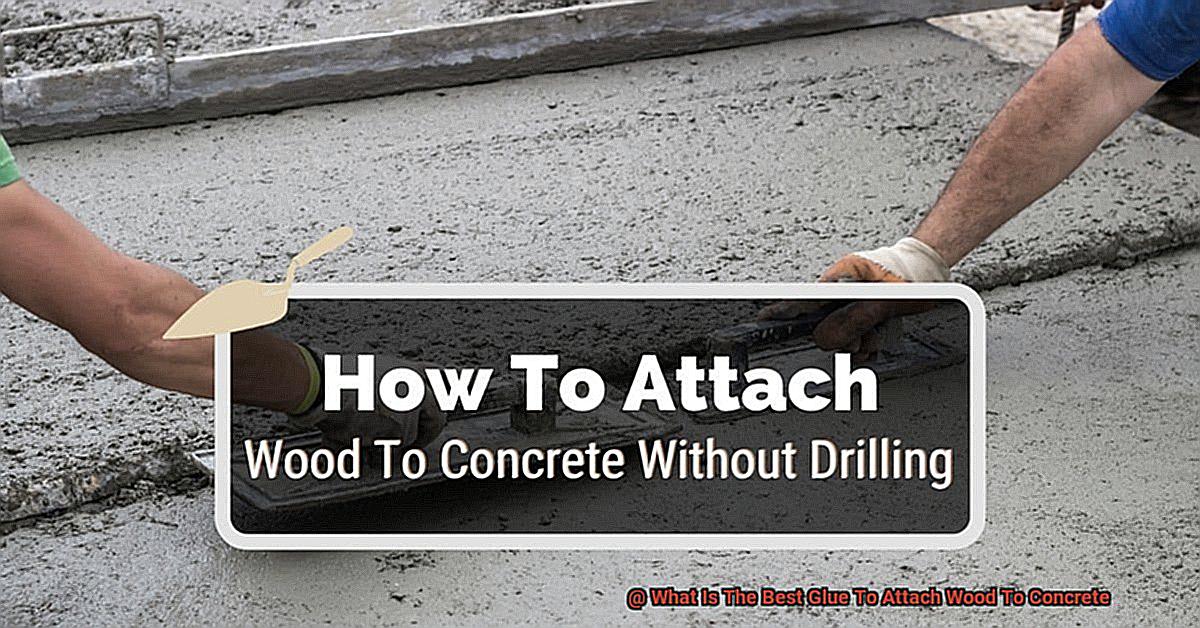
Prepare to embark on an exhilarating adventure as we uncover the secrets behind using mechanical fasteners in conjunction with glue in wood-to-concrete attachments. Brace yourself for a thrilling journey through captivating sub-topics, compelling lists, and expert insights that promise to equip you with the knowledge to forge unyielding connections.
Mechanical Fasteners – The Unyielding Guardians
When it comes to attaching wood to concrete, mechanical fasteners emerge as the unsung heroes of the process. Screws and nails step up to the plate, providing unwavering power that stops any unwanted shifting or movement in its tracks. These steadfast allies ensure stability and reinforce the connection.
- Strategic choices: Handpick mechanical fasteners based on crucial factors such as wood type, thickness, and anticipated load. Opting for screws or anchors is often favored due to their exceptional holding power and enduring grip.
- Penetrating perfection: Achieve the ideal balance by ensuring that your fasteners penetrate both the wood and concrete adequately, safeguarding against any potential splitting or cracking. In some cases, pilot holes may be necessary to accomplish this feat flawlessly.
The Bonding Sorcery of Glue
But lo and behold. There is more to this tale. Enter center stage – glue. This enchanting elixir works its magic by fortifying the bond between wood and concrete. It redistributes the load evenly, minimizing the risk of failure. Consider it your secret weapon against weak connections.
- Meticulous glue selection: Delve into the world of materials being bonded and environmental conditions. Epoxy-based glues reign supreme for their unparalleled bonding properties and resistance to moisture. Meanwhile, polyurethane construction adhesive provides flexibility, compensating for material expansion or contraction.
- Respect the instructions: Pay homage to the manufacturer’s guidelines, including thorough surface preparation and ample curing time. Remember, greatness cannot be rushed.
Unleashing the Combined Forces
When mechanical fasteners and glue band together, a force to be reckoned with emerges. This dynamic fusion forms an unyielding attachment capable of withstanding heavy loads and external forces, making it the ideal choice for high-stress applications.
Special Considerations for Certain Types of Wood
When it comes to attaching wood to concrete, there are several important factors to consider. Different types of wood have unique characteristics and properties that can affect the adhesion of glue to concrete. By understanding these special considerations, you can ensure a strong and durable bond between wood and concrete.
- Hardwoods: Hardwoods, such as oak, maple, and mahogany, are renowned for their strength and durability. When attaching hardwood to concrete, it is crucial to choose an adhesive that can withstand the weight and stress that hardwood can exert. Epoxy adhesives are an excellent choice for hardwood-to-concrete bonding due to their exceptional strength and ability to handle heavy loads. With epoxy adhesives, you can have peace of mind knowing that your hardwood will stay securely attached to the concrete surface.
- Softwoods: Softwoods, like pine or cedar, have a more porous and lightweight nature compared to hardwoods. This porosity can make it challenging for glue to penetrate the wood and create a strong bond with the concrete. To overcome this issue, polyurethane-based adhesives are often recommended for softwood-to-concrete applications. These adhesives have superior bonding properties and can easily penetrate the porous surface of softwood, ensuring a strong and reliable bond with the concrete.
- Engineered Wood: Engineered wood products, such as plywood and particleboard, consist of layers or particles of wood bonded together with adhesives. When attaching engineered wood to concrete, it is essential to choose an adhesive that can effectively bond both the wood layers or particles and the concrete surface. Construction adhesive is a suitable option for engineered wood-to-concrete bonding as it is specially formulated for use on various materials, including wood and concrete. With construction adhesive, you can ensure a secure and lasting bond between engineered wood and concrete.
- Exotic Woods: Exotic woods, like teak, rosewood, and ebony, have unique characteristics that require special care and consideration when attaching them to concrete. These woods often contain natural oils and resins that can make bonding with adhesives more challenging. To achieve a strong bond between exotic wood and concrete, it is recommended to use epoxy-based adhesives specifically designed for bonding oily or exotic woods to concrete surfaces. These epoxy adhesives are formulated to overcome the obstacles posed by the natural oils and resins in exotic woods, ensuring a reliable bond.
- Treated Wood: Treated wood, such as pressure-treated lumber, has undergone a chemical treatment process to enhance its resistance to decay, insects, and moisture. When working with treated wood, it is crucial to select an adhesive that can withstand the chemicals used in the treatment process. Polyurethane-based adhesives are generally suitable for bonding treated wood to concrete as they provide a strong and durable bond that can withstand the chemicals present in treated wood.
Consulting Experts or Professionals
Consulting experts or professionals in this field can be your golden ticket to success. So, gear up and get ready to explore the fascinating world of wood-to-concrete bonding, with advice from the pros who know.
Tap into the Expertise of Construction Pros:
Imagine having a direct line to seasoned contractors and builders who have mastered the art of gluing wood to concrete. These experts have tackled countless projects and can offer priceless advice on which glues work like magic. From hardwoods to softwoods, they’ve seen it all and know how to achieve an unbreakable bond. Get ready to soak up their firsthand experiences, tips, and tricks.
Unleash the Secrets of Adhesive Manufacturers:
When it comes to adhesives, who better to consult than the very manufacturers who create them? These professionals are true adhesive aficionados, specializing in developing and producing adhesives for various applications, including wood-to-concrete bonding. Their extensive research and testing ensure their products meet the specific demands of different materials. By tapping into their knowledge, you’ll gain access to the most suitable adhesive options available in the market.
Learn from Woodworking Wizards:
Carpenters and woodworkers possess an enchanting level of craftsmanship when it comes to working with wood and concrete. They’ve encountered unique challenges along their journeys, developing tried-and-true techniques and solutions. Their practical experience is a treasure trove of insights into the best glue options for your wood-to-concrete bonding adventure. Prepare to learn from these masters and elevate your project to new heights.
Personalized Guidance Tailored to Your Project:
One of the greatest benefits of consulting experts or professionals is the personalized advice they offer, tailored to your specific project requirements. They consider crucial factors like the type of wood and concrete, environmental conditions, and desired durability. With their guidance, you can make an informed decision and choose an adhesive that’s perfectly suited for your needs. Say goodbye to guesswork and hello to precision.
Conclusion
In conclusion, when it comes to attaching wood to concrete, the best glue for the job is a polyurethane adhesive. This type of adhesive offers excellent bonding strength and durability, ensuring that your wood stays securely attached to the concrete surface. Its unique formula allows it to penetrate into the pores of both materials, creating a strong bond that can withstand heavy loads and external forces.
Polyurethane adhesive also has the advantage of being resistant to moisture and temperature fluctuations, making it suitable for both indoor and outdoor applications. Whether you’re working on a woodworking project or installing flooring, this glue will provide a reliable and long-lasting bond.
When using polyurethane adhesive, it’s important to follow the manufacturer’s instructions carefully. Make sure to clean and prepare both the wood and concrete surfaces before applying the glue. Apply an even layer of adhesive to both surfaces and press them firmly together. Allow sufficient drying time for the glue to fully cure before subjecting it to any stress or load.
In summary, if you want a strong and durable bond between wood and concrete, choose a polyurethane adhesive. Its superior bonding strength, resistance to moisture, and temperature fluctuations make it the best choice for attaching wood to concrete in various applications.

